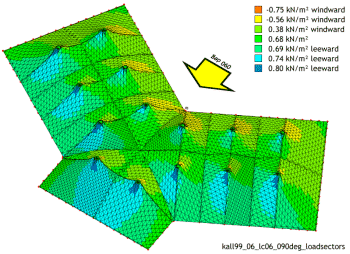Engineering of fabric membranes requires expertise in two primary areas; in the conceptual design and analysis of stressed skin structures and in the use of advanced geometry manipulation in the manufacture of the built form. In order to realise the complex three dimensional forms, it is necessary to use predominantly computer modelling techniques. Complex three dimensional shapes can be generated in special software suites which simulate applied environmental loads such as wind and snow. The software can compensate for different loads and component properties such as fabric stiffness and cable forces. At each stage of the design and analysis process the geometry can be checked for suitability for manufacture. The software can output not only technical information such as readouts of forces at node level to assist in specifying supports, but design aides such as graphic output of deflections and contours, in addition to membrane, cable, and vector forces. Cutting patterns are output from the three dimensional form to ensure the design information is optimised.
to use predominantly computer modelling techniques. Complex three dimensional shapes can be generated in special software suites which simulate applied environmental loads such as wind and snow. The software can compensate for different loads and component properties such as fabric stiffness and cable forces. At each stage of the design and analysis process the geometry can be checked for suitability for manufacture. The software can output not only technical information such as readouts of forces at node level to assist in specifying supports, but design aides such as graphic output of deflections and contours, in addition to membrane, cable, and vector forces. Cutting patterns are output from the three dimensional form to ensure the design information is optimised.
Compared to traditional buildings, fabric structures present a unique set of design challenges, as the shapes of membrane structures cannot be chosen at random. The absence of bending resistance requires designers to work within the constraints of feasible membrane equilibrium shapes, which can only be easily arrived at with the use of software. The structure can be considered in equilibrium when all forces and reactions balance each other out so that there is no net change. Membrane forms are usually complex, doubly curved surfaces which must be pretensioned in such a way as to resist applied environmental loading such as wind and snow. With a wealth of information at hand, every performance characteristic can be assessed. The post analysis form can be exported to visualisation packages to create photo realistic visuals and animated fly-through's which provide an unparalleled opportunity for a potential client to assess the project.
This design loop of feasibility study, cost analysis, structural analysis, design for code provision, manufacturing detailing, and transport and erection documentation forms a specialised branch of engineering which is practiced by a select few engineers in the world. A simple example that can be shown is that a typical membrane has single and multi layered fabric, reinforcing belts, and steel wire rope cables all bound together in a complex interaction of forces. These materials all exhibit different stretch characteristics which have to be allowed for in the manufacturing geometry. The materials have to be tested in the laboratory and the compensations included in the production drawings so that when the structure is installed all components in their loaded state arrive at the correct point in three dimensional space. An important part of the design process is final certification of the project. Certification and insurance are required for the safe use and operation of leading edge buildings and rely upon a high standard of engineering. As all potential, performance parameters can be assessed, most project information can be extracted.
Our design and manufacturing staff have developed specialised techniques for shape modelling, material testing procedures, structural analysis, cutting pattern generation, membrane seaming machinery and manufacturing techniques.
Most quality control measures centre around checking that the workshop has interpreted the manufacturing drawings correctly. This has been resolved by eliminating a whole level of manufacturing which was traditionally the 'black art' of tent making, i.e. the 'cut'. The three dimensional shape is turned into digital two dimensional cutting patterns and then exported into the cutter/plotter software, which automates the process, reducing potential errors.